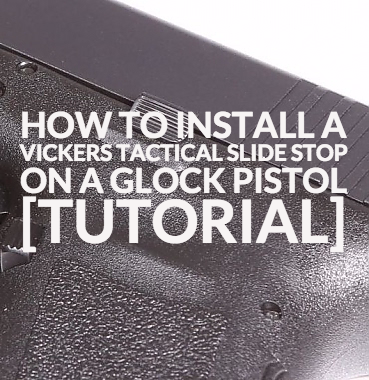It’s worth noting, that some people with large hands experience the pre-mature slide lockback even with the Vickers Tactical Slide Stop and prefer the OEM slide stop. That’s more proof not to modify your Glock (or other gun) unless something mechanical truly isn’t working for you.
So I decided to get the Vickers Tactical Slide Stop first, because it appeared to be a high quality part. Test it at the range, and if that still didn’t work, I’d order the OEM part as a last resort.
First, here’s what my Glock 19 Gen 4 looked like when I received it with the Glock extended slide stop — you can see how the rear part of it is quite pronounced and the ledge sticks out — making it easy to use, but also easy to accidently engage (at least for me and my hands).
Step 1: Get The Vickers Tactical Slide Stop and a Glock Armorer’s Tool
You’ll need the Vickers Tactical Slide Stop and a Glock Armorer’s Tool (or similar punch). You can click here to get them from Brownells.
Step 2: Fieldstrip The Glock
All you need to do is field strip it. Remove the slide and put it to the side. At this point, I realized I hadn’t cleaned my Glock in … somewhere close to 5,000 rounds so I went ahead and cleaned and lubed it real quick. I’m not a “white glove” gun cleaner by any stretch of the imagination.
Step 3: Punch out the bottom pin.
Very simply, take your Glock armorer tool and punch out the bottom pin above the trigger area.
Start from left side of the gun to right side as shown in the picture, and you may want to put the muzzle of the gun up on something to allow the pin to go through.
BIG TIP: If you are having trouble punching it through and out, wiggle the slide stop lever a little bit as you are punching it. Then it will eventually come out.
Step 4: identify where the slide stop sits, in a groove, right underneath the bar.
Here’s a pic of the gun looking from the top and I’ve outlined in red where the slide stop sits. It’s very simple. It sits there with the little spring under the bar (the arrow is pointing at the spring).
Step 5: Swap out the old slide stop with the new one.
Just change them out. The simple thing to do is look real hard at how the old one is sitting in there, take it out slowly watching how it goes out, then reverse the process putting the new one in. It’s pretty simple. Pic below is of the new slide stop in place.
Step 6: Put the trigger pin back in
Simply put the trigger pin back in from left to right again. Move the slide stop up and down, wiggling it a little if you have trouble. Might have to bang it a little to start it in.
Step 7: Function check your slide stop.
First manually rack and engage the slide stop to make sure it holds the slide back as shown in the picture below.
If that works then stick an UNLOADED magazine with NO BULLETS in it. Then rack the slide. The slide should stay locked back because the magazine is unloaded simulating an empty gun, like the pic below:
Step 8: Enjoy!
Here’s the final product, sitting next to the Glock extended slide release:
The Final Step …
Take it to the range as soon as possible to verify that you have not messed up your gun while actually shooting it!
I did that the very next day. The new slide stop seems to be working very well, I didn’t have even one instance of the slide prematurely locking back on a full magazine like I was having with the Glock extended slide release.
I hear good things about the durability of the Vickers Tactical Slide Stop too …
Firearms instructor Todd Green is known for doing very high round count torture tests of handguns and he not only suffered the premature lockback with the factory Glock extended slide stop but also broke not just one, but TWO Glock extended slide stops within about 20,000 rounds of shooting. The Vickers Tactical slide stop went 45,000 rounds before needing replacement — that’s basically 400% more durability.
So I’ll continue to run and test this slide stop on my pistol and if I have any problems with it, I’ll let you know.

